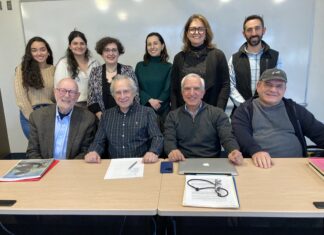By Hazel Antaramian-Hofman
I was born in 1960, in Yerevan, Armenia, yet spoke little Armenian and what I did speak was Western Armenian. As a young child, I always wondered why I came from such an exotic place when my father was born in Kenosha, Wis., and my mother was from Lyon, France. Only after years of hearing stories did I realize that I was the product of two Armenian Diaspora post-World War II repatriate children, who were compelled by their father and mother’s emotive sense of hayrenik to leave one known cultural and ideological ground for another.
The post-WWII repatriation movements uprooted many Armenians from all over the world: France, Lebanon, Egypt, Greece, Cyprus, Syria, Bulgaria, Romania, Palestine, the United States, even some from Sudan, Iran, Iraq, India, Uruguay, Argentina and China. It was an orchestrated campaign to repopulate what fraction that remained of a vast land well-documented as the ancestral home of Armenians from the time of Darius the Great. But the repatriates were headed not to the romanticized, vast ancient land of their forebears, but to a “sovietized” Armenia under Stalin. It was a migratory event complete with personal and spiritual dispossession and cultural disparity.
The Republic of Armenia was in a state of extreme poverty after World War II. By November 1945, Stalin authorized the return of Armenians to Soviet Armenia with the incentive of bringing in new life in the construction, vitalization and economic development to a destitute Soviet Republic. Armenian nationalistic organizations, political parties and religious leadership organized efforts of the repatriation. The Armenian Repatriation Committee stressed the need to nationally support the country of Armenia while downplaying the reality that Armenia was now a Soviet-dominated country.
The basic repatriation story is riddled with individual twists and turns, but in most cases, there was a common thread: more often, a nationalistic, or at times, a socialist-leaning decision was made by a patriarch or a matriarch, who uprooted their family in response to an emotional global appeal encouraged by Soviet propaganda. The call to Armenians worldwide was a maneuver to attract young people of child-bearing ages; to secure skilled workers and professionals from developed countries; and to obtain new technologies and products. Encouraged by promises of free housing, land to build upon and job opportunities, those who left the Diaspora made their life-altering move with false hope. Upon their arrival, they witnessed unimaginable social and economic conditions, with no opportunity to leave the Soviet bloc Armenia or regain their confiscated citizenship papers. The collective social memory of many hayrenadartsner was one of betrayal and deceit under the guise of a patriotic call. Those who survived the times would later tell stories concerning backward social economics, disease, discrimination, psychological anxiety and physical brutality encountered under the Soviet system. Zabel (Chookaszian) Melconian, a 23-year-old New York native left the United States in 1947, to support her father’s decision to move to Armenia. After experiencing abysmal living conditions, she recalls trying to warn her relatives in America not to come to Armenia by sending them cryptic messages in outbound letters, which were routinely censored.
Scholarly articles, lectures and testimonial documentation have only begun to shed light on this period in Armenian history. Crosby Phillian, a native New Yorker, who left the United States in 1949, at the age of 16, says that “survival” was the sole mantra of many repatriates who when living in Armenia had to sell their personal belongings on the black market for a few rubles in order to eat for the week. The sale of goods on the black market became a ritual every Sunday. Anxiety-ridden akhbars were at the mercy of those who had some money and knew how to work the system. Phillian, who currently lives in France, also notes that the unwritten law in the Soviet Union at the time seemed to be standing in long lines to buy basic food items, such as bread, meat or cheese. Bursting crowds, arguments and physical fights were not unusual occurrences in these lines. There was even an occasional death. Phillian remembers when a man who was trying to simply buy some cheese was killed by a woman’s shoe heel striking his head.








